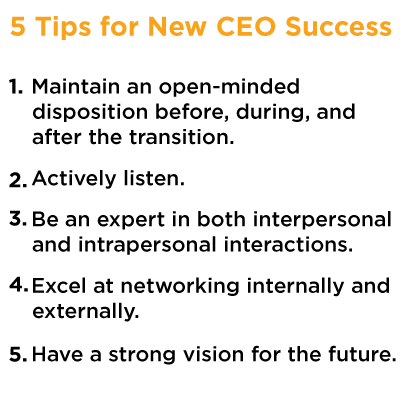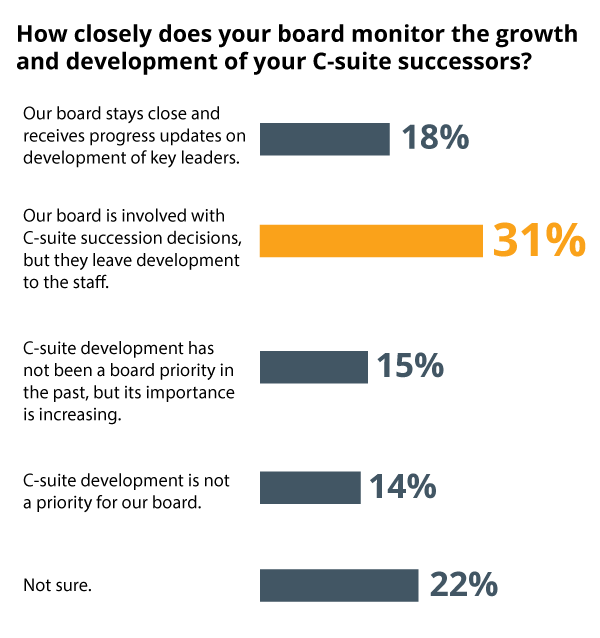A challenge that every board faces is visibility. In their duty to provide governance and oversight of management, it can be a constant struggle to gain unfiltered access to what is actually happening inside the organization, without becoming over-involved to the point of obstruction. Nowhere does this challenge present itself more vividly than in the board’s top responsibility: CEO succession.
Maintaining leadership continuity at the top is every board’s accountability, but there is tremendous variability in how boards and CEOs collaborate on this critical work, and how CEOs are monitored in their leadership of the succession process.
Indeed, the riskiest scenarios may be those in which the CEO and company are performing the best. CEOs in these cases (often board chairs as well) are understandably granted more latitude and face less scrutiny and pushback from their boards. But that approach can often leave unpleasant surprises for the board when the new CEO takes over.
The recent return of Bob Iger as Disney’s CEO illustrates yet another boomerang scenario in an who found they had no alternative other than to bring a prior CEO out of retirement. Results from these returning CEOs have been , highlighting the obvious conclusion that boards don’t bring back former CEOs unless they have no other option. And when it comes to CEO succession, the absence of optionality is risk.
What’s the CEO’s Role in Succession?
Let’s be crystal clear: CEO succession is the board’s accountability, not the CEO’s. All boards should know by now that nothing can be taken for granted when it comes to choosing the next chief executive, no matter how high-performing the current CEO may be. The CEO naturally plays a leading role in facilitating the CEO succession process, but the board and shareholders are the customers, and the CEO must fulfill the assignment in a way that enables the highest likelihood of a successful transition.
Across thousands of CEO and C-suite succession decisions, I and my team have seen great variability in the dynamics between boards and CEOs in the succession process. In this short article I will highlight several of the most significant factors and questions that every board should tune into when creating and managing expectations for the CEO’s leadership of succession.
How Should the Board Manage the CEO’s Role in Succession?
I once observed the board of a large technology company asking the CEO (who was also the board chairman) a series of questions about CEO succession. One director asked about development of the COO, who was one of the top candidates: “Could you share more about your plans for their development?”
The CEO tapped the side of his forehead with his index finger, saying, “It’s right up here.” In other words, he alone knew the development plans and would be overseeing them himself. Not surprisingly, this wasn’t the answer the board director was hoping for, and appropriately so.
CEO succession is a multifaceted process of identifying successor candidates, assessing capabilities, providing developmental experiences, and evaluating readiness for the job. These phases evolve over time and require full collaboration and transparency among the board, CEO, CHRO, and succession candidates.
It’s true that the CEO plays the most pivotal role in facilitating that process, and typically the CEO’s judgments about candidate readiness carry more weight than others’. But boards must be cautious to not allow this to drift into an unspoken assumption that the CEO presides over all of CEO succession.
Questions the Board Should Ask ��ɫ���� the CEO’s Role in the Succession Process
- Does our CEO communicate, solicit input, and build involvement from the board in all aspects of the CEO succession process?
- Is the CEO succession planning process the product of collaborative input and dialog with the full board?
- Does our CEO understand and act in a way that recognizes that succession is the board’s accountability?
- Is it clear that our CEO understands that the final choice of a successor is the board’s decision?
- When does the board need to start planning for CEO succession?
In our experience, a significant portion of organizations that begin working on CEO succession are companies in which the CEO has been in place for less than one year.
Why?

Many CEO transitions are rocky. They may take too long, bring unwanted turnover in the C-suite, garner stakeholder criticism, or follow a period of poor CEO performance. In all these instances, the board prefers not to retread the difficult territory, and so the new CEO is asked to begin working on their own succession plan shortly after they sit down in the chair.
This is a healthy impulse. CEO succession is not simply a decision that takes place every 5-10 years. It is a permanent process in which organizations are constantly preparing leaders in ways that equip them if they are called on to fill a critical vacancy. This requires a constant sense of urgency, not an episodic one.
Conversely, when boards don’t start this process early, it can become increasingly difficult to do down the road, particularly when you have an who has little intention of handing over the reins. As a result, companies often end up with failed successions and .
Questions the Board Should Ask about the CEO Succession Timeline
- Where is the impetus for CEO succession coming from? Has our CEO established succession as a priority and provided the appropriate amount of attention and resources?
- Is CEO succession a routine topic of board discussion? Or has the topic been tabled because the current CEO is seen as likely to be in position for the foreseeable future?
- Do we have a good idea of our CEO’s intentions and how long they are likely to remain in the role?
- Is there an emergency succession plan in place? Are there clear instructions for how succession (and communications surrounding it) will be handled if the incumbent is suddenly unable to fulfill the role?
How Should the CEO Cultivate a Diverse Successor Pool?
A continuous sense of urgency is also necessary to build a broader, deeper, more capable and representative pool of leaders with the potential to take on multiple C-suite assignments, including the CEO role.
Time and again, organizations report the absence of sufficiently experienced candidates as a principal reason for the predominance of white men in the C-suite and in CEO roles. While we can point to various antecedents for this dilemma, there is one thing that every organization can do to address it: start sooner—much sooner. And think more broadly.
When starting to consider CEO succession candidates, most boards and CEOs look reflexively to the senior team. Who among them shows the promise of becoming CEO?
From the standpoint of building diversity of thought, experience, skill, and identity, this is a nonstarter. Succeeding in the development of more diverse enterprise-level leadership requires reaching much further down into the organization, starting far sooner, and actively building developmental experiences for people who can begin to show the organization different versions of what successful leadership looks like. Your CEO (with guidance from HR and DEI leadership) must champion these efforts.
Questions the Board Should Ask ��ɫ���� the CEO’s Planned Successor Pool
- Is our CEO interested in starting the succession and development process early, with leaders at least several levels below the CEO?
- Is the list of potential CEO candidates more than one or two people (ideally 6-10) and are their backgrounds, experiences, skills, and identities diverse?
- When our CEO discusses the CEO succession candidate pool, do they reference its diversity and have a perspective about how to expand it?
- Does our CEO seek to involve a diverse group of stakeholders who can provide unique perspectives and offer insight into how best to promote diversity in the C-suite?
How Should the Board and CEO Define the Success Profile of the Next CEO?
While the board will make the final succession decision, the CEO’s judgments about candidates, capabilities, developmental progress, and final readiness will play a large (perhaps the largest) role in influencing that decision. So the CEO’s perspective and implicit definition of leadership matters a great deal.
This should not be left to the independent discretion of any one person. All CEOs and board members have their own beliefs about leadership and what it takes to succeed at the top, and in a decision process as consequential and complex as this one, that variability represents risk.
CEO success is determined by a mix of experience, skill, personality, and motivation, all combining uniquely within each individual to align (or not) with the organizational context. There is no simple prototype or critical “it” factor that determines success. For that reason, it is essential for the CEO and board to align around the success profile and leverage multiple objective inputs and data to make evaluations against it.
Questions the Board Should Ask ��ɫ���� the Next CEO’s Success Requirements
- How does our CEO identify leadership potential? What criteria are considered primary? Does the board agree?
- Does our CEO have a philosophy about leadership and what it takes to be successful at the top? Is it a broad definition that goes beyond track record and experience, or does it zero in on a narrow band of characteristics? Does the board share the same perspective?
- Have the CEO and board together confronted the future leadership challenges that the CEO and senior team are likely to face? Does the CEO success profile address them?
How Should the CEO Coach Their Potential Successors for Growth?
Much can be done to prepare successors for the CEO role, but not if the incumbent . This requires a mindset anchored by the assumption that leaders can grow—significantly.

The Chairman and CEO of a major energy sector corporation adopted this mindset more than four years ago as he began to consider retirement. Having been somewhat surprised by his own ascent into the CEO role, he knew that growth could happen in significant and unexpected ways. For him and his board, CEO succession became far more than preparing one or two candidates. Instead, development was aimed at the entire senior team (and some below it).
A two-year effort was aimed at defining enterprise leadership success factors, assessing leaders in the C-suite, and building aggressive development strategies for each individual and the entire senior team. Some leaders swapped roles. Others were given assignments to handle high-stakes strategic initiatives. Speaking roles in earnings calls were spread around the senior team, giving everyone access to these key leadership moments and many others.
The results stunned everyone. As the time came to select a CEO successor, the available data about each team member was extensive. Not only did the board understand the unique profile of each leader, they understood what each had done to enhance their skills over the last two years. Now, two years into the new CEO’s tenure, the team remains entirely intact, and company performance hasn’t skipped a beat.
Questions the Board Should Ask ��ɫ���� How the CEO is Coaching and Developing Successors
- Does our CEO exercise creativity in both identifying potential successors and in finding ways to cultivate their growth (e.g., special assignments, collaboration on key projects, exposure to unique audiences and situations)?
- Does our CEO convey confidence in the ability of leaders to grow beyond expectations? Do they display a belief that people change and develop?
- Has our CEO zeroed in on one or two potential successors, or is there an effort to create a culture of growth across the entire senior team?
How Can the Board Ensure that the CEO Succession Process has Appropriate Rigor?
Succession and development can feel like work that is outside the boundaries of managing the business. And as a result, many CEOs downplay its importance and take a more casual, informal approach. This is obviously a misguided judgment in one of the most consequential decisions any board can make and has led to many unforced errors in corporate leadership.
CEO and C-suite succession is best administered as a permanent process of senior leadership development that is periodically interrupted by the need to make a decision about who will be the next CEO (or CXO). As such, some degree of structure and commitment to tangible indicators of progress is warranted.
At the most fundamental level, every succession system should include phases to confirm the CEO success profile, identify a diverse pool of successors, assess successors’ leadership capabilities against the CEO success profile, and engage successors in development activities that catapult their capabilities forward in ways that benefit the business.
Questions the Board Should Ask ��ɫ���� the Rigor in the CEO Succession Process
- Has our CEO communicated a clear process that will be followed in administering the CEO succession process?
- Are there clear phases and milestones in the succession process, and is the board being briefed regularly and fully on progress in each one?
- Is our CEO getting professional guidance about how to plan and structure the CEO succession process?
- Is our CEO succession process leveraging benchmarking data and insights that ensure we are utilizing the most contemporary methods and criteria?
In Conclusion:
CEOs Are Inexperienced at Succession
While experienced board members may end up guiding multiple CEO successions over the course of their board involvement across organizations, very few CEOs have ever seen the inner workings of a succession process outside of their own. Thus, even an incredible CEO who outperforms in every other area likely has a very limited frame of reference to guide their own succession.
And frankly, many CEOs also struggle to think of someone else being able to fill the role as well as they do. It’s a part of human nature.
That’s why it’s so essential that the board keeps a very high level of visibility into the process and maintains a sense of urgency at all times to ensure that growth is happening. In fact, managing CEO succession and the CEO’s role in that process may be the most fundamental thing the board does to mitigate risk and ensure continuity as unexpected challenges emerge.
For more about the specific conversations the board, CEO, and CHRO should have throughout the succession process, check out our four-part series on the CEO succession planning conversations you MUST get right:
- CEO Succession Planning Conversation Part 1: Identifying Successors
- CEO Succession Planning Conversations Part 2: Successor Development Invitations
- CEO Succession Planning Conversations Part 3: CEO Bench Strength Review
- CEO Succession Planning Conversations Part 4: CEO Successor Readiness
Matt Paese, Ph.D., is Senior Vice President, Succession Management & C-Suite Services at DDI. He leads DDI’s Executive Services group, where he and his team help CEOs, boards, senior teams, and executives enhance leadership to grow business, cultural, and personal success.
Topics covered in this blog


